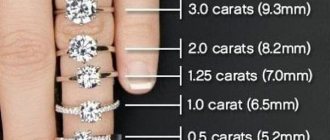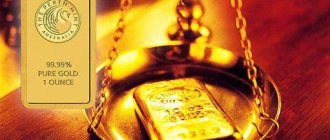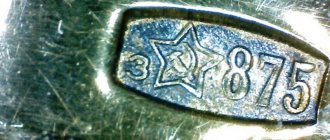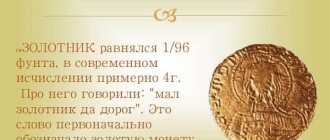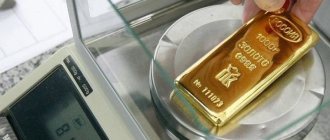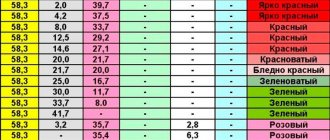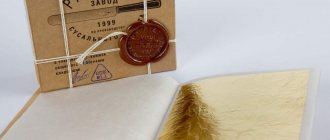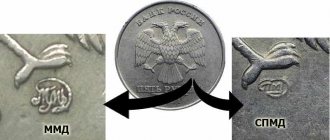History of the emergence of jewelry measures
The mining and sale of precious stones dates back many centuries. In order to profitably sell gems, it was necessary to somehow determine their weight. The first weight standard was the grains of cereals that grew on a particular continent. The grains were selected in such a way that each grain was of the same weight and size.
The birthplace of most precious minerals was the countries of the Ancient East, where the standard of weight was considered to be the seeds of the carob tree - ceratonia. This plant was the ideal unit of measurement for the ancient Romans, since regardless of growth processes, each tree produced grains of identical size, weighing 189 mg each. The carob tree is considered the founder of the term “carat”.
Mediterranean countries used acacia seeds, which are relatively uniform in size and weight, to determine the weight of stones and gold. When Emperor Constantine ruled the Greeks, the country minted the solidus coin. The weight of this gold coin was equivalent to 24 acacia grains, which laid the basis for the emergence of the term “carat hallmark” as a definition of the purity of the metal.
It is also known that in European countries the weight of precious stones was determined using barley grains, which were the smallest of the cereals in the area. There is a version about a coral tree that grew in hot countries, the grains of which are almost equal to the weight of a carat. However, this position of the emergence of a jewelry unit of measure is the least likely.
Is a carat a diamond's best friend?
Often people, thinking about how many grams 1 carat is, think that we are talking only about diamonds. Is it so?
It turns out no, carat is a measure of weight for all gemstones.
And that is why, a carat (that is, 0.2 grams of weight) of precious stones may differ in appearance. One carat of diamond, emerald or sapphire looks different.
You may be interested in: Gold refining at home: the best and proven methods
If you remember a little about the school physics course, namely that the density of substances differs, everything falls into place.
The same 1-carat stones may differ in appearance, since there are more than 250 cutting methods.
Measurement systems of different countries
Until the beginning of the 20th century, there was no unified system for measuring the weight of precious stones. Each “point of sale” of expensive minerals around the world used its own measure. Because of this, confusion arose when trying to determine the value of the gem, because the difference in weight sometimes reached 0.026 grams, which is quite significant. In Russia, since 1922, it has been generally accepted that 1 carat is 200 mg or 0.2 g.
Metric carat
In 1907, in Paris, the IV General Conference on Weights and Measures adopted the official weight measure for precious minerals and pearls - the carat, which was equivalent to 0.2 grams or 200 mg. The metric carat quickly became the standard jewelry measure for most countries.
English carat
In England, the local measure for the weight of gems was 205.4 mg. The entire weight system of the country, including jewelry, was based on the troy pound, the main English unit. This unit in turn was divided into several others, ultimately resulting in a troy grain equal to 64.79 mg. A carat was equal to 3.17 troy grains until 1888. Afterwards, the Ministry of Commerce determined the weight of the English measure as 205.3 mg. Since 1914, England has used the world metric system.
Arabic carat
The canonical karat or qirat was used throughout Iraq. There, the jewelry unit of measurement was equal to 1/14 of the weight of the local silver coin - the dirham, which is proportional to 223.2 mg. The Kirat of Syria, Egypt and Mecca differed significantly in weight, answering 195 mg. At the same time, the Egyptian qirat was put in relation to its own measures of weight - bakila and shamuna. The Kyrat of Asia Minor was also different, equaling 204 mg.
Alternative weights
In addition to the generally accepted carat weight system, jewelers use the following terms:
- Jewelry gran is a unit equal to ¼ carat or 50 mg. Today it is no longer used. Previously, the weight of pearls was determined using grains.
- Gram is a unit used in purchase and sale transactions of raw materials. In jewelry making, it is important to know how many grams are contained in one carat in order to estimate the approximate weight of the stone that can be obtained from this raw material.
- Momme is a measure of weight that is used only by the Japanese to measure the mass of pearls. Momme is 18.75 carats.
The carat of a stone is one of the main criteria for assessing the value of a precious mineral. Therefore, to set the price of a gem, measurements are carried out with maximum accuracy. In abbreviated form, the carat value of a stone is denoted “ct”.
How many grams in one carat
At the beginning of the 20th century, jewelers agreed on the exact number of grams in a carat. In 1907, they decided to equate the weight of one carat to 0.2 grams. However, not all countries agreed to convert the mass into carats, continuing to use their own values. The countries adopted a unified standard in the following sequence:
- France - 1907
- Holland - 1911
- USA - 1913
- USSR - 1923
Following these states, other countries also decided to convert grams to carats. However, a 1 ct gem is a rare and expensive stone. Much more often you come across crystals with a smaller mass, not reaching 0.2 grams. But here, too, jewelers did not use standard measures and created their own unit - the point. It has been established that one ct (0.2 grams) is equal to 100 points.
Carat price of gemstones
Today, precious stones and jewelry with them are considered not only an attribute of secular society, but also a profitable financial investment. Some minerals reach values of tens and hundreds of thousands of dollars. Diamonds remain at the price peak, although some rare minerals are confidently ahead of diamonds in this struggle for leadership.
Top five gems
Despite the large number of scientific classifications of minerals, based on various characteristics, there is still no clear division of stones. After all, sometimes a flawless rare gem is several times higher than the cost of a diamond of poor quality. However, a conventional five precious minerals have been identified that top the list of the most expensive stones:
- Diamond. The cost of 1 carat of diamond starts at 15 thousand dollars, determined by a number of criteria. But there are also so-called “folk” diamonds - stones of 0.1 ct that cost about 10,000 rubles. Carbonado, a black diamond with an average price of $150/ct, is considered inexpensive. The best stones reach 500-600 $/ct.
- Emerald. Estimated from $350/ct. This refers to the lowest quality stones. An emerald with ideal characteristics starts at $8,500/ct, increasing in price in proportion to the size of the nugget - a top-quality cut emerald weighing 5 carats or more costs about $15,000/ct.
- Ruby. Low quality red corundums sell for $100/ct. But if a red nugget is assessed as flawless, then the price per carat of such a stone soars to 15 thousand.
- Sapphire. The most expensive is cornflower blue corundum. The heated mineral sells from 300 to 1000 $/ct. A mineral that cannot be heat treated starts at $1000/ct. The orange Padparadscha sapphire is considered a rare gem. Its price starts from 130 $/ct. A collectible piece weighing 5 carats or more can cost about $30 thousand.
- Alexandrite. A stone weighing 3-5 carats of lower quality sells for 600-2500 dollars. The best specimens cost up to $22,000/ct. The record price for a carat of Russian alexandrite sold at auction was $70,000.
The five stones that top the lists of the most expensive minerals in the world are not the last selection of beautiful gems that belong to the category of precious stones.
Video about the cost of 1 carat of diamond:
Diamond quality rating:
Popular precious minerals
The list of fascinating stones can be continued indefinitely, but the highest positions are occupied by:
- Tanzanite – average price – $500 per carat. The best samples reach $1000/ct.
- Topaz is the most valuable untreated imperial stone of a yellow hue, estimated at 70-500 $/ct, pink - from 500 to 3500 $/ct.
- Sultanite – green palette – 100-150 $/ct. Complex color combinations are twice as expensive.
- Demantoid – 200-300 $/ct. Large specimens reach $1000 per carat.
- Corundum - depending on the variety and quality - from $50-100 to several tens of thousands per carat.
- Noble spinel – the price starts from 20-30 $/ct, reaching 1000 $/ct for rare specimens.
- Amethyst – from 20 to 100 $/ct.
- Rauchtopaz (smoky quartz) – 900-8000 rubles per stone.
- Garnet – from 600 to 2000 rubles per carat.
Artificial cubic zirconias are very popular - they shine en masse in jewelry, successfully copying diamonds. But their cost is cheap - 10-15 dollars for a bag of 100 pieces of medium-sized stones, 50 dollars for a similar volume of multi-colored raw materials.
Meaning of the word carat
Examples of the use of the word carat in literature.
What if this cunning servant of the black forces is testing him, and behind the door there is probably a company of young men on duty with black belts in karate, or even worse - some telepaths practicing astral kung fu.
It is useful to wear aquamarine beads and applique stones weighing up to 5 carats on the cervical and thoracic spine for 15 minutes.
With modesty and the ability to blend into the background, things were not going well for them, but they got the hang of using boxing and karate to beat faces well: sixteen-year-old Antoine, the youngest - fifteen-year-old Boris and Antoine's bosom friend, their paternal cousin, sixteen-year-old Robert, surrounded by several friends every night they disappeared on the dance floor in a nearby park and for two weeks now they stopped getting into fights: there were no more people willing to do so.
Starting with swimming, Mishima then moves on to bodybuilding, kendo, and karate.
Finally, Yura remembers that he left the group in Nazran near a bookstore, that he bought an interesting book about karate and began reading it, and that he got to Vladikavkaz by bus, etc.
Dalki's sports karate could not be compared with the ferocious school of airborne hand-to-hand combat, where all styles and trends were mixed, subordinated to one single goal - to kill the enemy.
And then one of the guys who blocked the path of the intrasensory jumped and kicked him in the head - he, like everyone else in the first group, was a professional fighter of one of the schools of kenkon, the art of fighting, based on knowledge of improved techniques of ancient types of hand-to-hand combat: taekwondo, karate, sambo, shi-kai and others.
Then the guru added: “Let her wear a bracelet directly on her body with a two-carat pearl, which should be held on the bracelet only by clips.”
The line on the touchstone showed a purity greater than 23 carat gold.
To the right of the regent's throne stands the chief herald and head of His Holiness's personal guard, the legendary Carl Linga William Eiheji - archer and painter, master of karate and ikebana, philosopher and ex-flyer - as always, in excellent shape, and very much resembles a flawlessly functioning mechanism.
He even refused the ten-carat stone offered to him, although his eyes lit up predatorily when diamonds brought from Israel appeared on his daughter-in-law’s ears and index finger, the same ones that had been kept for several years in the leg of a chair, dear as a memory of their ancestors.
If we translate the price of one carat into gold, then in almost all times, as today, it is equal to the cost of one hundred grams of gold.
But a two-carat stone costs three times more than a one-carat stone, and a three-carat stone costs nine times more.
This 88.7-carat stone at one time saved the lives of tens of thousands of Russian and Persian soldiers.
A historically famous masterpiece at one time was considered a pearl almost the size of a pigeon's egg, weighing one hundred and thirty-four carats or 27 grams.
Source: Maxim Moshkov library
The relationship between the weight and size of the stone
There is a misconception that the weight of a gemstone characterizes its size. But the physical and chemical nature of minerals is designed in such a way that different gems of the same weight have different sizes due to different densities. Compared to a diamond, a one-carat sapphire or ruby will be smaller in size, but an emerald will be larger.
Another indicator that determines the size of a stone is its cut. According to this criterion, even diamonds of the same weight differ in size.
These sizes are indicated for cut group A. For other cut groups, sizes may vary slightly.
So, a one-carat diamond will have completely different sizes, depending on the cut:
- Circle. The most popular cut shape. The diameter of this stone is 6.5 mm. Round diamonds, regardless of the number of facets, are the most expensive, since the lion's share of the precious weight is lost during processing.
- "Marquis". A cut that was born thanks to the favorite of the King of France. The diamond, reminiscent of the smile of the Marquise de Pompadour, measures 9.8 * 5.6 mm.
- Square. This shape implies different types of cuts, the most popular of which are “Princess” and “Asscher”. Size – 5.55*5.55 mm.
- Oval. Size – 7.7*5.9 mm. The brilliance of oval diamonds is identical to that of round stones, but the former benefit from their size.
- "Cushion" and "Radiant". Square cut with beveled edges, stone size 6*5.5 mm.
- "Pear". This shape is a tandem of two other shapes – circle and “Marquise”. Size – 8.6*5.8.
- Heart. A cut designed to hide the natural imperfections of a diamond, measuring 6.7*6.5 mm.
- "Baguette". A one-carat stone has a size of 7.7 * 4.5 mm. The brilliance of a piece of this shape outshines the brilliance of round diamonds.
- Emerald. Size – 6.4*4.9 mm. This type of cut is only suitable for flawless stones. Otherwise, this form will highlight all the shortcomings. Emerald shapes shine brighter than round ones, but the latter better convey the play of color.
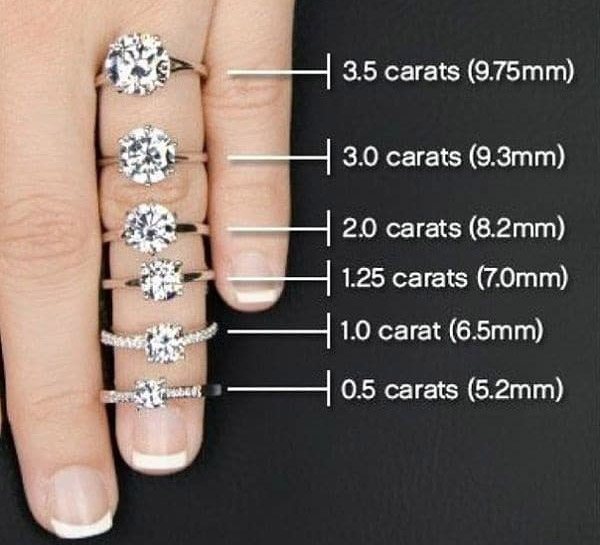
If we talk about the weight of diamonds, then the carat plays a decisive role only in the evaluation of small stones. When determining the cost of large specimens, first of all, they take into account the indicators of purity and color.
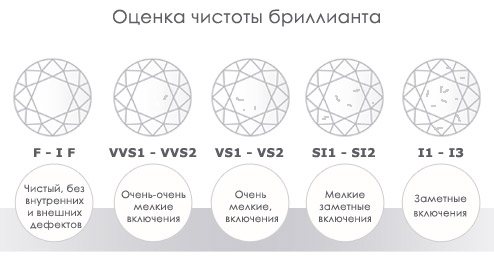
Stone purity table
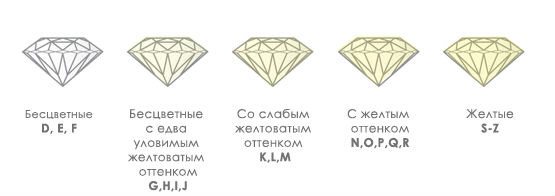
Diamond Color Chart
Carat of precious metals
The term "carat" is also used to define the purity of precious metals or the amount of precious metal in an alloy. The hallmark carat is designated by the letter "K" or "kt".
Today, countries such as the USA and Canada use the karat system. The pure metal alloy has a purity of 24 carats. Depending on the proportion of noble metal content in the alloy, samples are distinguished:
- 23K - the mass of the noble metal is 0.958 of the weight of the alloy.
- 22K – 0.916.
- 21K – 0.875.
- 18K – 0.750.
- 14K – 0.583.
- 12K – 0.500.
- 9K – 0.375.
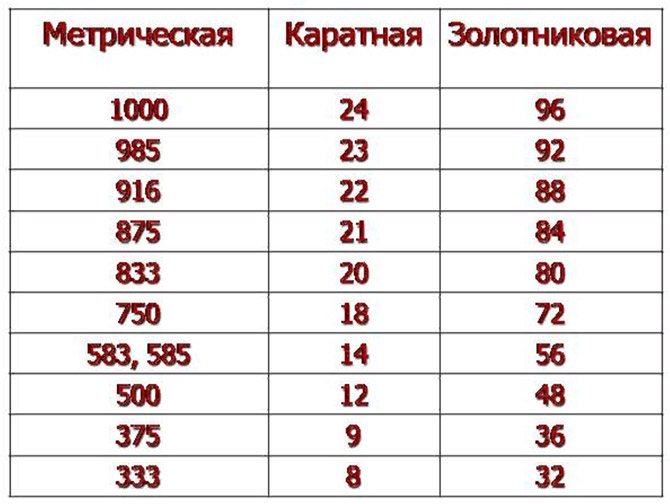
In the countries of the former Soviet Union, since 1927, the metric system of measures has been used, which determines the assay of various alloys by the ratio of the amount of noble metal in 1 mg of the alloy. Various hallmarks are defined for platinum, gold, silver and palladium. The karat standard is easily converted to the metric system with two simple mathematical steps. To do this, the carat value is divided by 24 and multiplied by 1000.
The metric testing system is used by dozens of countries in Europe and the world. Ireland uses both hallmarks on the product mark. England puts a metric measure on the stamp, but the description of the product (exclusively made of gold) also allows for a karat standard.
Note
In addition to the carat, jewelers use another unit of measurement – the point. So, 1 carat is equal to 100 points. The weight of the stone is measured with an accuracy of 1 point, which is equal to 1/100 of a carat. It is believed that this unit of measurement was invented in order to bypass the standard metric system. After all, when it comes to diamonds, stones weighing 200 mg or 1 carat are rare, found only once among 250 tons of processed diamond ore.
When buying a diamond, you should know that it is impossible to visually distinguish a stone weighing 0.96 carats from a specimen weighing 1.02 carats. But the price of the former will be half that of the latter.
5 / 5 ( 3 voices)
